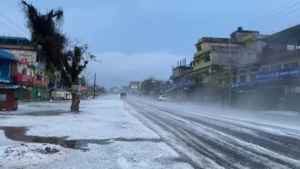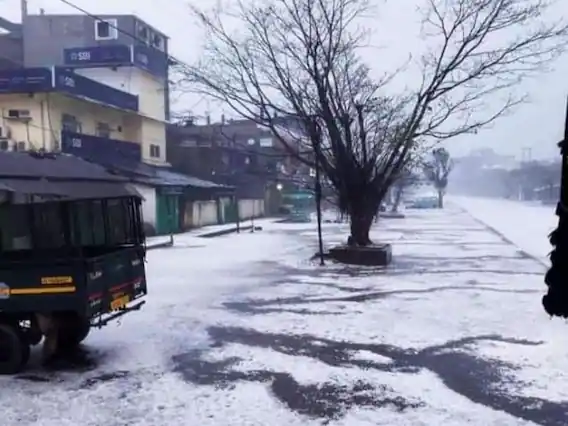Physical Address
23,24,25 & 26, 2nd Floor, Software Technology Park India, Opp: Garware Stadium,MIDC, Chikalthana, Aurangabad, Maharashtra – 431001 India
Physical Address
23,24,25 & 26, 2nd Floor, Software Technology Park India, Opp: Garware Stadium,MIDC, Chikalthana, Aurangabad, Maharashtra – 431001 India

By Manjori Borkotoky and Aayushi Sharma (with inputs from Dr Partha J Das)
Assam’s Dibrugarh district was recently affected by a severe hailstorm on December 27, 2022. As per reports, around 500 houses were damaged and photos and videos of the hailstorm lashing the Moran area in the Dibrugarh district immediately went viral on social media. The hailstorm lashed Lahowal, Lekai, Moran, Tingkhang, Naharkatia, and other adjoining areas. A senior official from the Dibrugarh district administration informed that though there has been no record of any casualty, as per preliminary assessment in Moran sub-division, 310 houses were damaged in 37 villages.

A similar case of hailstorm happened in Kuwait recently which is among the hottest countries on Earth. Recently, it has been hit by a rare hailstorm and the locals shared images of the white layers of hailstones on social media. Kuwait’s meteorological department said that the precipitation there had reached up to 63 millimeters. Muhammad Karam, a former director of Kuwait’s meteorological department said, “We have not seen so much hail during the winter season in 15 years.” Karam further said that this phenomenon might reoccur as climate change is disrupting weather patterns all over the world.
Climate Change, Hailstorms, and Northeast India
“Winter hailstorms are not uncommon in various parts of India, neither in NE India. However, the intensity, area of impact, and effect on the lives of people in the localities of occurrences observed in recent years in the NE region is a new experience,” said Dr Partha Jyoti Das, Senior Climate and Environmental Scientist and also Inhouse Consultant of CFC.
Assam’s Dibrugarh district was recently affected by a severe hailstorm on December 27, 2022. Earlier, many parts of the city of Guwahati were lashed with hails creating a snowfall-like situation on February 25, 2022. Even before that, Shillong experienced large-scale hailstorms on January 22, 2022, and December 22, 2021.

“The pre-Christmas hail showers in Shillong in 2021 was a unique event in the recent climatological history of the NE region. It captured nationwide media and scientific attention. However, the post-Christmas Moran hailstorms in the just bygone year will be remembered both as a rare occurrence as well as an extreme event of a hydrometeorological disaster causing widespread damage to agriculture (winter vegetables, tea, and other horticultural crops) as well as houses and other public and private infrastructure,” Dr Das said.
“Occurrence of hailstorms in north-western and northern India in the winter season (e.g., December, January, and February) is not unusual, but at the same time, winter hailstorms are not a commonplace event either in these parts of India. Especially, winter hailstorms in the northeastern region of India are considered a rare phenomenon. Hailstorms in the winter months are not ubiquitous because it requires a combination of meteorological situations that are generally not available in the winter season in these parts of the country,” Dr Das added.
“It has been observed by some Indian scientists that such hailstorms are generated when there is a simultaneous presence of a convective circulation at the lower tropospheric level, the incursion of moisture carrying air either from the Arabian sea or the Bay of Bengal, and an active Western Disturbance (WD) at the mid-tropospheric height. The convective ascent of the moisture-bearing air masses, when they interact with the cold and wet streams of air in the Western Disturbance, results in intense nucleation of ice and large-scale cloud formation and further updraft of the cold air and clouds lead to the production of hail stones that precipitate with rains. Such preconditions are not fulfilled easily and every now and then produce a situation conducive to the creation of hailstorms in the winter season,” Dr Das explained.
“As defined by the India Meteorology Department (IMD), the WD is a cyclonic circulation or troughs in the mid and lower tropospheric levels or a low-pressure area on the surface, which occurs in middle latitude westerlies and originates over the Mediterranean Sea-Caspian Sea-Black Sea region and moves eastwards across north India towards the Western Himalayas in North-western India and Central Himalayas in Northern India extending sometimes to the Eastern Himalayas, when they affect the northeast Indian region too. These upper-level synoptic-scale weather systems are embedded in the subtropical westerly jet stream (STWJ),” Dr Das further explained.
Frequent and Intense Hailstorms might be an impact of Climate Change, still more research needed
According to a study titled, ‘The effects of climate change on hailstorms’, published in the journal Nature, “Uncertainty on the effects of climate change on hailstorms remains very high. This high uncertainty is due in part to hailstorms being relatively rare and relatively small-scale, both of which make them difficult to observe and model over the time scales required for trend analysis. Reducing the uncertainty will require a “process-based” approach in which understanding of processes affecting hailstorms, their interactions, and their changes under climate change are considered.”
Dr. Pranab Deb, Centre for Ocean, River, Atmosphere and Land Sciences (CORAL), IIT Kharagpur explained in an email to CFC India, “A warmer atmosphere can hold larger quantities of moisture which can lead to heavier hail precipitation during convective storms. There is evidence of a statistical correlation between increasing temperature and hail frequency in some cases. Interestingly, the long-term trend in the hail frequency and size has been spatially heterogeneous.”
Dr Deb stressed the fact that more scientific research is needed to understand if the intensity of hailstorms in India has increased because of climate change.
“However, attribution of an individual event to global warming is tricky, and at this stage, we need more scientific research to understand if and how the occurrence of high-intensity hailstorms in India is due to global warming,” he said.
Dr Das, on the other hand, said that while it is difficult to understand precisely if and how the winter hailstorms are linked to climate change, it is highly likely that the recent trend of large-scale hailstorms in India could be an impact as well an indication of climate change.
“The hailstorm that broke loose in the National Capital Region of Delhi on January 17, 2013, surprised both scientists and the inhabitants of New Delhi because it was a rare occurrence in the New Delhi area. The New Delhi region witnessed more such incidents of hailstorms in the winter season in recent years, e.g., March 29, 2013; February 7, 2019; March 14, 2020; January 6, 2021, and February 25, 2022. The hailfall was accompanied by heavy precipitation and widespread cloud cover in the north Indian region,” explained Dr Das.
Scientists have concluded that the presence of convective circulation at the lower troposphere helped in the rise of moisture-laden air masses incurring from both the Arabian sea and the Bay of Bengal to the mid-tropospheric level where it encountered a cold rush of westerly winds induced by an episode of Western Disturbance. The resulting baroclinic instability and availability of convective energy caused a further upward draft of the cold air leading to the formation of cloud and ice nucleation at mid and high tropospheric levels. These processes ultimately led to the formation of large hailstones which precipitated with rains and winds.
“Scientists have noted a trend of weakening of the intensity of WDs of late. However, the probability of high and extreme rainfall in the winter induced by the WDs is found to be high. However, it is still not clear how climate change has affected the WDs. Therefore, it is difficult to understand precisely if and how the winter hailstorms are linked to climate change,” Dr Das added.
“The La-Nina which has been persisting with full vigor in the eastern Pacific region and has been dubbed one of the longest La Ninas (Triple dip la Nina) recorded in the last two centuries, could also play a role in creating situations conducive to the freaky incidents of sleet and hailfalls. The moisture-bearing low-pressure convective systems are known to be thermally driven due to surface warming. Since most of these global and regional synoptic systems are known to be affected by climate change, it is highly likely that the recent trend of large-scale hailstorms in India could be an impact as well as an indication of climate change. However, we should wait for more conclusive evidence obtained through rigorous research for such conclusions to be drawn with confidence,” he concluded.
Loss and Damage
It is of utmost importance that winter hailstorms are studied and predicted with reasonable accuracy so that their impact on human lives, livelihoods, and assets can be reduced with proper disaster preparedness. The severity of the Moran hailstorm should act as an eye-opener for our disaster managers. The Disaster Management Authorities should monitor loss and damage caused by such winter weather extremes.
It is also pertinent in this context to remember that the WDs play an important role in controlling atmospheric temperatures, especially in creating cold weather, fog formation, triggering winter rains, snowfall, glaciation as well as landslide, winter flooding, and avalanches in the Himalayas. Surveillance of the WDs and similar weather extremes is necessary for reducing the climate risk of a large vulnerable population in India.
Comments are closed.
Hmm is anyone else experiencing problems with the images on this blog loading? I’m trying to find out if its a problem on my end or if it’s the blog. Any responses would be greatly appreciated.
[…] Also, read this in English […]
obviously like your web site but you have to check the spelling on quite a few of your posts. Many of them are rife with spelling issues and I find it very troublesome to inform the reality nevertheless I’ll definitely come back again.